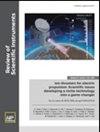在充气磁化二极管中形成定向宽孔径失控电子流
IF 1.3
4区 工程技术
Q3 INSTRUMENTS & INSTRUMENTATION
引用次数: 0
摘要
本文介绍了磁绝缘空气二极管的研究、开发和测试结果,这些二极管带有可更换的石墨和不锈钢管状阴极和同轴阴极,具有不同的结构,能够产生定向的失控电子束。在阳极,电子束的横截面为外径 1-2 厘米的圆形或环形。电子束携带的电流从几安培到几十安培不等,持续时间从几十皮秒到 100 ps 不等,电荷量从十分之一纳库仑到几纳库仑不等。束电子在电流脉冲峰值时的动能通常为 150 千伏。电子束参数是通过改变驱动二极管的亚纳秒高压脉冲的振幅和持续时间来设定(和改变)的;它们取决于阴极材料以及外加磁场的强度和轮廓。保持横截面结构的束带从二极管中沿着磁场线被带出,穿过薄箔或网状阳极,进入两个亥姆霍兹线圈之间具有准均匀磁场的开放空间。在这个空间中,可以放置要接受电子辐照的样品,类似于各种实验和技术应用中暴露在辐射下的物体。本文章由计算机程序翻译,如有差异,请以英文原文为准。
Formation of directed wide-aperture flows of runaway electrons in air-filled magnetized diodes
This paper presents the results of research, development, and testing of magnetically insulated air diodes with replaceable graphite and stainless-steel tubular and coaxial cathodes of various configurations capable of generating directed bunches of runaway electrons. At the anode, the bunches have cross sections shaped as circles or rings with an outer diameter of 1–2 cm. The durations of the bunches, which carry currents of a few to tens of amperes, range from tens of picoseconds to 100 ps, and their charges range from tenths of a nanocoulomb to a few nanocoulombs. The kinetic energy of the bunch electrons at the peak of the current pulse is typically of the order of 150 keV. The bunch parameters are set (and varied) by varying the amplitude and duration of the subnanosecond high-voltage pulse driving the diode; they depend on the cathode material and on the strength and profile of the applied external magnetic field. The bunches, retaining their cross-sectional structure, are brought out from the diode, along the field lines, through a thin foil or mesh anode into the open space with a quasi-uniform magnetic field between two Helmholtz coils. In this space, the samples to be irradiated with electrons, similarly to objects exposed to radiation in various experiments and technological applications, can be placed.
求助全文
通过发布文献求助,成功后即可免费获取论文全文。
去求助
来源期刊

Review of Scientific Instruments
工程技术-物理:应用
CiteScore
3.00
自引率
12.50%
发文量
758
审稿时长
2.6 months
期刊介绍:
Review of Scientific Instruments, is committed to the publication of advances in scientific instruments, apparatuses, and techniques. RSI seeks to meet the needs of engineers and scientists in physics, chemistry, and the life sciences.
 求助内容:
求助内容: 应助结果提醒方式:
应助结果提醒方式:


